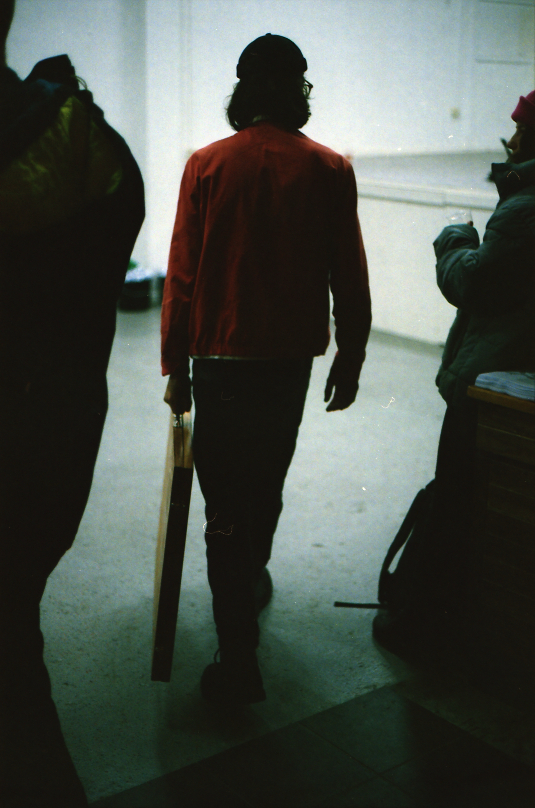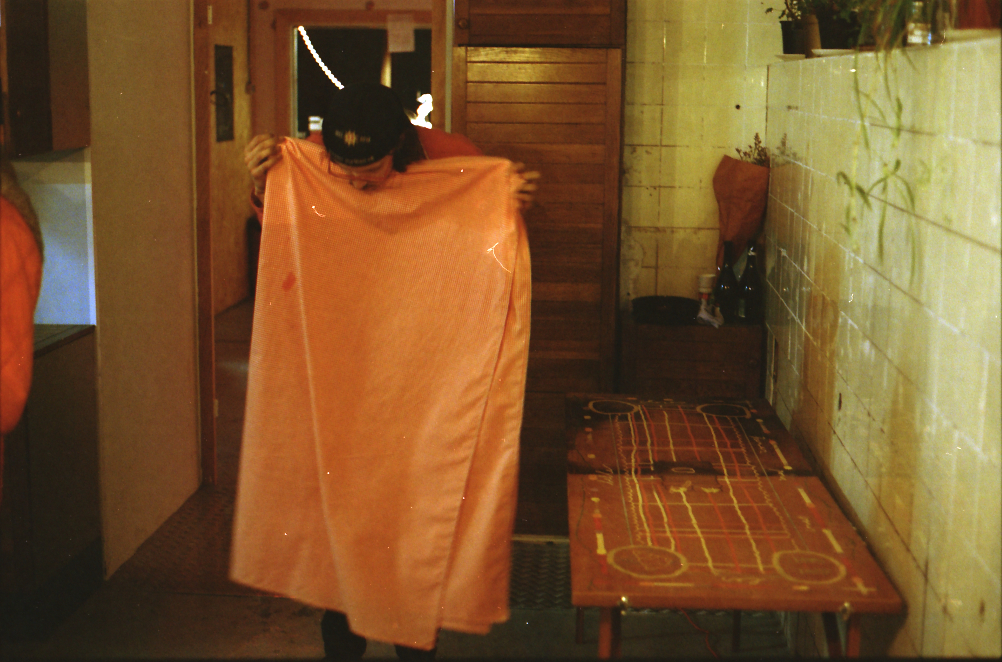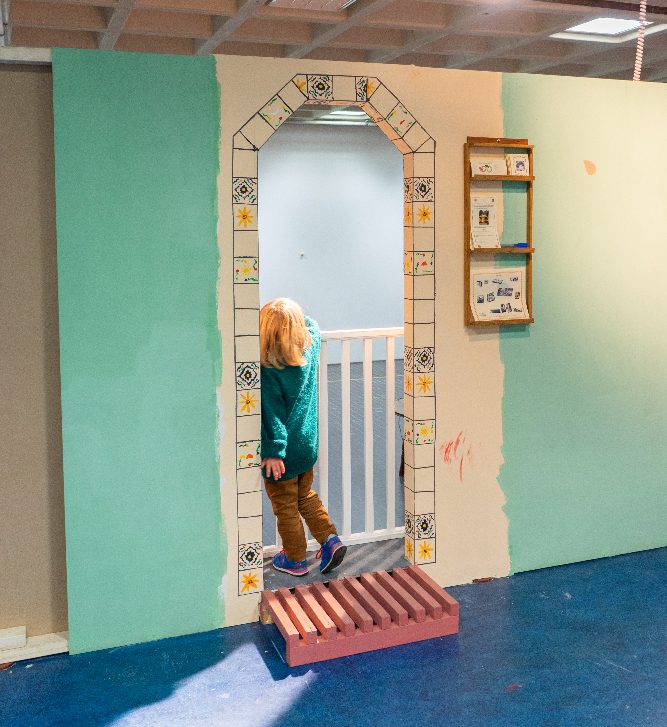Stroom Invest interview / artist Jan Dirk Adams
Hybrid and diverse practices have become the norm over the years. Classification and labelling are more and more a thing of the past and something that people will just shrug over most of the time. More valued is an open mindset and attention to what is going on in the world. The practice of Jan Dirk Adams is an example of such a mindset. Working as a writer, performer, curator, co-running the art space Hgtomi Rosa, while having roots in painting, sculpture, taking his inspiration from literature and taking cues from the game Go to develop new scripts, he is very much an example of overcoming a straightforward classification.

Can you tell us something about your background?
“After highschool I first went to study Illustration at the Willem de Kooning Academy. However, after two years I switched to the Royal Academy of Art (KABK) because I wanted to do more with painting. I fell in love with KABK’s amazing studios and really wanted to work there instead. Eventually I switched from painting and started doing sculpture, which in turn led me to performance. The thing was, I realised that I loved working with unpredictable coincidences and existing situations. A good example would be my graduation exhibition of 2019, for which I built a messy room which resembled a student cafeteria. In the room were some performers that were performing following a script I had written, which was based on actual student conversations. To the audience it mostly looked like there were some students there that were just relaxing in that space. Using scripted performances mixed with reality is very typical of my work nowadays.”
You were one of the last people to graduate pre-pandemic, how has it been as a recent graduate to start working in such an environment?
“That is hard to say, especially since part of my work is that I adapt to whatever situation presents itself to me. At the end of 2020 I did a project together with Suzie van Staaveren called Kifl the Kid Salon in Billy Town and because of the pandemic we got more time for our project, which wasn’t too bad. Also, we got to work with smaller groups rather than a big crowd and that was quite nice. It was relatively easy to adapt to the measures put in place at the time. Only one exhibition of mine got cancelled during the last half of its scheduled exhibition time. For this exhibition I had written an extensive script for a performance, where two strangers could get to know each other by following the step by step plan provided to them. Luckily I managed to perform this piece at a different exhibition.”
How do you develop your performances?
“My work is roughly divided into two parts. The first part would be the situation or space where the performance is to be held. I will analyse the space and its architecture and see if it needs a big structural adjustment, such as a wall, or maybe the space needs smaller adjustments like some props placed about the place. I am quite precise in the way that I think a space should be like for me. I prepare an extensive mise-en-scene, with all little bits laying about the room, so it looks and feels lived in. For me, this process is very much akin to that of painting. The second part of the work is writing the scripts for the performers. Which can be either very detailed or just a loose step-by-step plan, dictating how performers should interact with the audience. I usually don’t take part in the performance, or at least, I don’t have a very defined or fixed role in the whole.
I really like being part of group shows because it allows me to play and move about the space, almost like a satellite orbiting the space. For one exhibition I made a folding table that had a very detailed inlay on top. It was used by a performer throughout the exhibition in a variety of ways, following a detailed map with instructions. Sometimes it was used for drinks or to display a publication. In its use it was very much embedded in the situation but there were moments where it also stood by itself and it briefly escaped its context and function.”


Your work is very subtle and it borders on mimicking reality, but doesn’t it bother you that the audience might see one of your performances and miss that there is something going on?
“I like it when you can’t easily isolate art from reality because it allows you to go beyond the very limited art experience that you might have otherwise. Seeing or experiencing art is something that is a trained relationship, something that has actively been taught. It would be sad if you would only perform that trained type of behaviour to works of art. I want to make art that is as capricious and weird as life itself. Works of art become very rich if they are unpredictable. The scripts and the situations that I create are nothing but fiction, which is allowed to dissolve if the audience decides to go against the script during one of my performances. The audience is allowed to dictate their own story if they wish to do so; everyone is allowed to decide their own position. I am mostly looking for open interactions that allow for complex exchanges.”

How is it possible that on the one hand you want to completely control every detail of the room, and on the other hand you allow anything to happen within it?
“What I try to do in the space is to create a certain atmosphere, in order to tempt people to stick around and hang about in the space. Many times it is unclear whether or not it is an art space or just any space; there are a lot of small bits and pieces laying around to generate white noise as it were, giving the audience an idea that something is happening or has happened, but never really clear what it is. I want them to be able to be in the space without really having to focus on anything in particular. The script and the space serve as a structure for interaction to happen.
One source of inspiration for me is the ancient Chinese board game of Go. It is an abstract strategy board game in which the aim of the game is to surround more territory than the opponent. The rules of the game are incredibly simple but there are an infinite amount of ways you can play this game. Currently I am part of Go club, together with other artists, in which we research the game and ways that people have used the game as a source of inspiration for other works. One famous example is the Oulipo group, a loose group of writers and mathematicians who seek to create works using constrained writing techniques, akin to the game of Go. It was founded in 1960 by Raymond Queneau and François Le Lionnais. Other notable members have included novelists Georges Perec and Italo Calvino, poets Oskar Pastior and Jean Lescure, and poet/mathematician Jacques Roubaud. In our Go club we also have a small literary programme where one person will bring in a text, which could be related to the game of Go in whatever way, and discuss it. It is mostly about sharing new ideas and insights with one another. For me, the game of Go is a great thinking exercise and a way to learn how certain structures and limitations allow for unexpected things to happen. You learn to play intuitively, rather than always being able to put things into words precisely and plan every move.”

What are you currently working on, especially since you got the Stroom Invest Grant?
“With the Stroom Invest Grant I wanted to do a number of things, one of which was a large exhibition, but mostly I wanted to settle some pragmatic matters such as creating a stable environment for me to work in. My work is quite unstable by nature and easily influenced by whatever situation I find myself in; the Stroom Invest Grant has helped me because it allows me to spend more time at my studio so I can develop new works.
At the moment I am working on a lot of projects at the same time. I am working on a project called “Open” (working title) together with Dimitri van den Wittenboer, which will be a space that will be open 24/7 for at least one month. We will design an interior for it, which mostly serves to steer the project a bit. We want to let people in and see what kind of use they have for this particular space. There won’t be any rules, we will work together with whoever shows up and we will see what will happen. We are interested in creating things together and abandoning the role as an author.
Also, this May I will be performing together with Constantijn Scholten at the Stockholm Supermarket Art Fair for Alternative Art Guide. For a long time I have been wanting to do something with telling a story about a family, which comes from my fascination with literature. Literature is very important to me and one of the things I love about it is how you can analyse the way they have constructed the story. We had been asked by Rob Knijn from Stichting Alternative Art Guide to make an art piece about a semi-fictional art initiative. The brief was very specific but it lined up quite well with what I had been wanting to do. So together with Constantijn we have come up with a big story about a Swiss family at the turn of the 19th century. We have done a lot of research about this and together we have constructed a whole framework in which this story takes place. We will present this at the Supermarket Art Fair, almost as an educational presentation complete with lots of infographics.”
Stroom Invest Week is an annual 4-day program for artists who were granted the PRO Invest subsidy. This subsidy supports young artists based in The Hague to develop their artistic practice so that artists and graduates of the art academy can continue to live and work in The Hague. To give the artists extra incentive, Stroom organises this week consisting of studio visits, presentations and several informal meetings. The intent is to broaden the visibility of artists from The Hague through future exhibitions, presentations and exchange programs. Stroom Invest Week 2022 will take place from 7 to 10th of June.